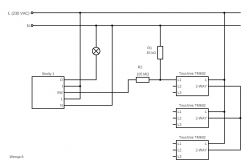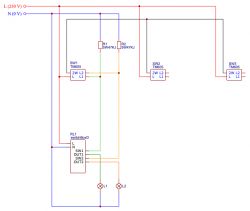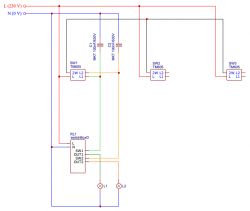Hello!
I am in the final stages of finishing the flat. The lighting on the electrical side has been implemented in the traditional way – on mechanical switches, in places in stair and stair-cross arrangements. At the last minute, however, I began to lean towards installing touch switches, and specifically fell for Touchme (albeit not yet the final choice).
First and foremost, I want to be able to control all the lighting remotely (via Wi-Fi), so I had planned from the start to use aftermarket relays like Shelly 1 (for single) / Shelly 2.5 (for double). However, the Touchme range offers switches with built-in Wi-Fi control, so this simplifies things considerably. Unfortunately, the exception to this is their touchme staircase and cross-over switches, where remote control would have to be realised in-house.
Here you can find sample wiring diagrams provided by the manufacturer.
Below is my output circuit – Touchme connectors successfully control the consumer (energy saving bulb 12 W):
 .
.
I had assumed that the connection of such a coupler to a Shelly should not be particularly different from the connection to an ordinary mechanical coupler. Unfortunately – I was wrong. Below is my first attempt. The result: the Touchme connectors are not active because, I conclude, they do not detect the load.
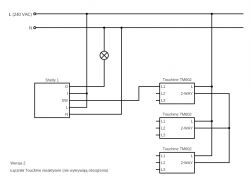 .
.
I concluded that adding a parallel load should solve the problem. I decided on a 15 kΩ resistor (5 W). And indeed – the touchme switches became active again and the L1 output of the first one again showed a phase as a result of switching. Unfortunately, however, there was a lack of agreement between Touchme and Shelly, which was detecting a high state at the SW input all the time. Because of this, regardless of the state of the switches, the light was continuously on.
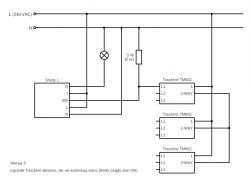 .
.
I should add that I verified the operation of the Shelly relay itself – by connecting and disconnecting the phase to the SW input, the light turned on and off accordingly. The Shelly configuration is also appropriate – mode toggle switch . Additionally, I have several copies and each has behaved in the same way.
My conclusion is that in the off state, the Touchme switches do not completely cut off their outputs (L1, L2 and L3), but current can still flow through them, which I guess is used for load sensing.
Would anyone have any ideas on how to solve this problem? Perhaps use other Wi-Fi controlled relays? Or maybe insert an additional, ordinary relay between Touchme and Shelly or somehow filter the L1 output of the Touchme connector?
I would only ask that you take into account the rather limited space of the boxes. Although, at my request, additional boxes have been made next to the boxes for the stair and cross connectors, exclusively for the remote control elements, but their capacity is small.
I would be very grateful for any suggestions and help.
I am in the final stages of finishing the flat. The lighting on the electrical side has been implemented in the traditional way – on mechanical switches, in places in stair and stair-cross arrangements. At the last minute, however, I began to lean towards installing touch switches, and specifically fell for Touchme (albeit not yet the final choice).
First and foremost, I want to be able to control all the lighting remotely (via Wi-Fi), so I had planned from the start to use aftermarket relays like Shelly 1 (for single) / Shelly 2.5 (for double). However, the Touchme range offers switches with built-in Wi-Fi control, so this simplifies things considerably. Unfortunately, the exception to this is their touchme staircase and cross-over switches, where remote control would have to be realised in-house.
Here you can find sample wiring diagrams provided by the manufacturer.
Below is my output circuit – Touchme connectors successfully control the consumer (energy saving bulb 12 W):
 .
.
I had assumed that the connection of such a coupler to a Shelly should not be particularly different from the connection to an ordinary mechanical coupler. Unfortunately – I was wrong. Below is my first attempt. The result: the Touchme connectors are not active because, I conclude, they do not detect the load.
 .
.
I concluded that adding a parallel load should solve the problem. I decided on a 15 kΩ resistor (5 W). And indeed – the touchme switches became active again and the L1 output of the first one again showed a phase as a result of switching. Unfortunately, however, there was a lack of agreement between Touchme and Shelly, which was detecting a high state at the SW input all the time. Because of this, regardless of the state of the switches, the light was continuously on.
 .
.
I should add that I verified the operation of the Shelly relay itself – by connecting and disconnecting the phase to the SW input, the light turned on and off accordingly. The Shelly configuration is also appropriate – mode toggle switch . Additionally, I have several copies and each has behaved in the same way.
My conclusion is that in the off state, the Touchme switches do not completely cut off their outputs (L1, L2 and L3), but current can still flow through them, which I guess is used for load sensing.
Would anyone have any ideas on how to solve this problem? Perhaps use other Wi-Fi controlled relays? Or maybe insert an additional, ordinary relay between Touchme and Shelly or somehow filter the L1 output of the Touchme connector?
I would only ask that you take into account the rather limited space of the boxes. Although, at my request, additional boxes have been made next to the boxes for the stair and cross connectors, exclusively for the remote control elements, but their capacity is small.
I would be very grateful for any suggestions and help.









